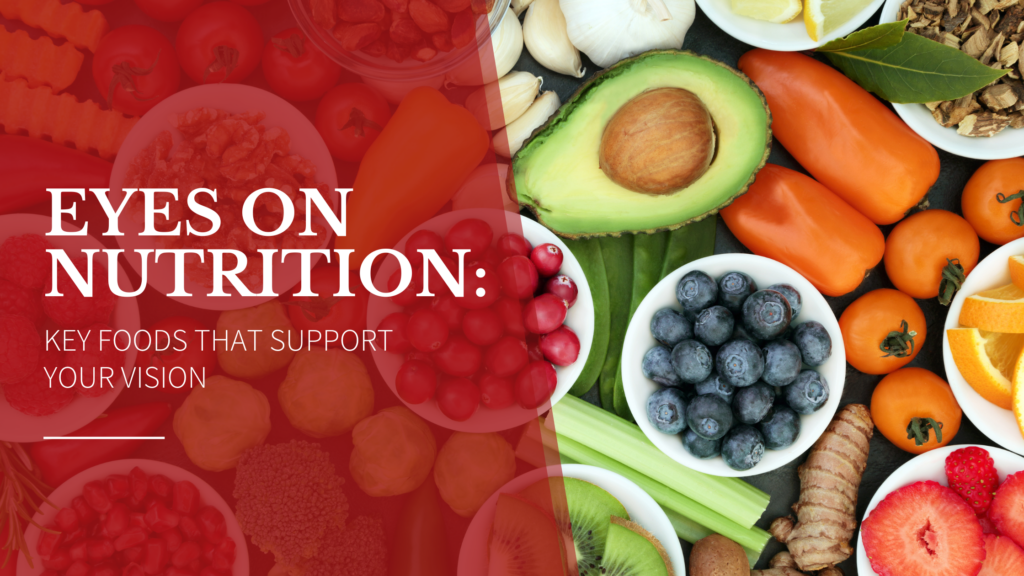Did you know that what you eat can significantly impact your eye health?
A diet rich in essential nutrients like vitamins C and E, zinc, lutein, zeaxanthin, and omega-3 fatty acids can lower the risk of developing age-related macular degeneration (AMD), cataracts, and other eye conditions. While research is still ongoing about the role of diet in glaucoma, it’s clear that good nutrition is crucial for maintaining healthy vision. Here’s a comprehensive guide on how to incorporate these vital nutrients into your diet and protect your eyes for the long term.
Key Nutrients for Eye Health
Vitamin C
- Benefits: Acts as an antioxidant, protecting the eyes from damage caused by free radicals.
- Sources: Oranges, grapefruit, kiwifruit, strawberries, tomatoes, red and green peppers, and broccoli.
Vitamin E
- Benefits: Another potent antioxidant that helps maintain healthy cells.
- Sources: Almonds, sunflower seeds, olive oil, and avocados.
Zinc
- Benefits: Vital for maintaining the retina’s health and may protect against light-induced damage.
- Sources: Legumes (beans and lentils), seeds, meat/seafood, dairy, and eggs.
Lutein and Zeaxanthin
- Benefits: Found naturally in the retina, these carotenoids help filter harmful blue light and maintain healthy cells.
- Sources: Leafy greens like kale, spinach, and swiss chard, as well as broccoli, asparagus, and colorful fruits such as raspberries, papaya, peaches, and mangoes.
Preventing Cataracts with Antioxidants
What are Antioxidants?
Antioxidants protect our cells by slowing or preventing the oxidative process that leads to aging and cell death. They are essential in reducing the risk of cataracts by preventing changes to the proteins and fats in the eye’s lens.
Antioxidant-Rich Foods:
- Vitamins A, C, and E: Found in carrots, sweet potatoes, citrus fruits, bell peppers, and strawberries.
- Carotenoids, Lutein, and Zeaxanthin: Present in leafy greens, broccoli, and colorful fruits.
While supplements are available, it’s best to get antioxidants from natural food sources when possible.
The Mediterranean Diet: A Model for Eye Health
The Mediterranean diet, rich in plant-based foods and seafood, can lower the risk of heart disease and AMD. This diet includes:
- Green leafy vegetables and colorful fruits
- Tree nuts like almonds, cashews, and walnuts
- Seafood as the primary meat source
- Healthy fats like olive oil over butter
- Whole grains and legumes
- Herbs and spices to reduce salt intake
- Moderate dairy and eggs
Low-Glycemic Index Diets
For those with or at risk for diabetes or AMD, a low-glycemic index (low-GI) diet can help maintain stable blood sugar levels. This involves choosing foods that cause gradual increases in blood sugar:
- Oatmeal or muesli over sweetened cereal
- Brown rice over white rice
- Whole-grain bread over white bread
- Durum wheat pasta or sweet potato over baked potato
- Nuts over potato chips
Omega Fatty Acids and Dry Eye
While omega-3 and omega-6 fatty acids are thought to help with dry eye, scientific evidence is not conclusive. Natural sources include:
- Omega-3: Oily fish like salmon, trout, and sardines.
- Omega-6: Nuts and oils such as walnuts and sunflower oil.
Fish and Macular Degeneration
Eating fish rich in omega-3 fatty acids twice a week may reduce the risk of AMD and benefit heart health. However, pregnant women should consult their doctors about safe fish consumption due to mercury levels.
Good nutrition is essential for maintaining healthy eyes and overall health. When considering ways to improve your eye health, keep in mind that vitamins and nutritional supplements cannot cure eye diseases or restore lost vision. However, good nutrition is essential at every age, benefiting your whole body and playing a crucial role in maintaining healthy eyes. Talk to your ophthalmologist about any concerns and the best dietary choices for your eye health.
